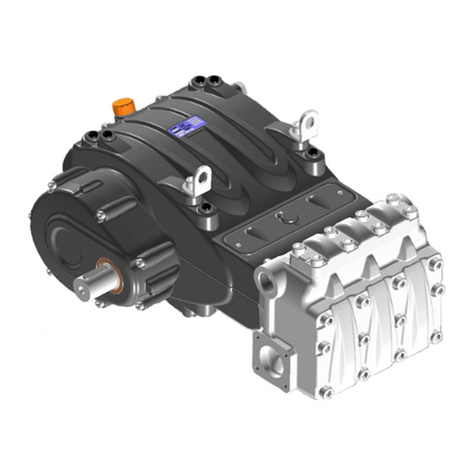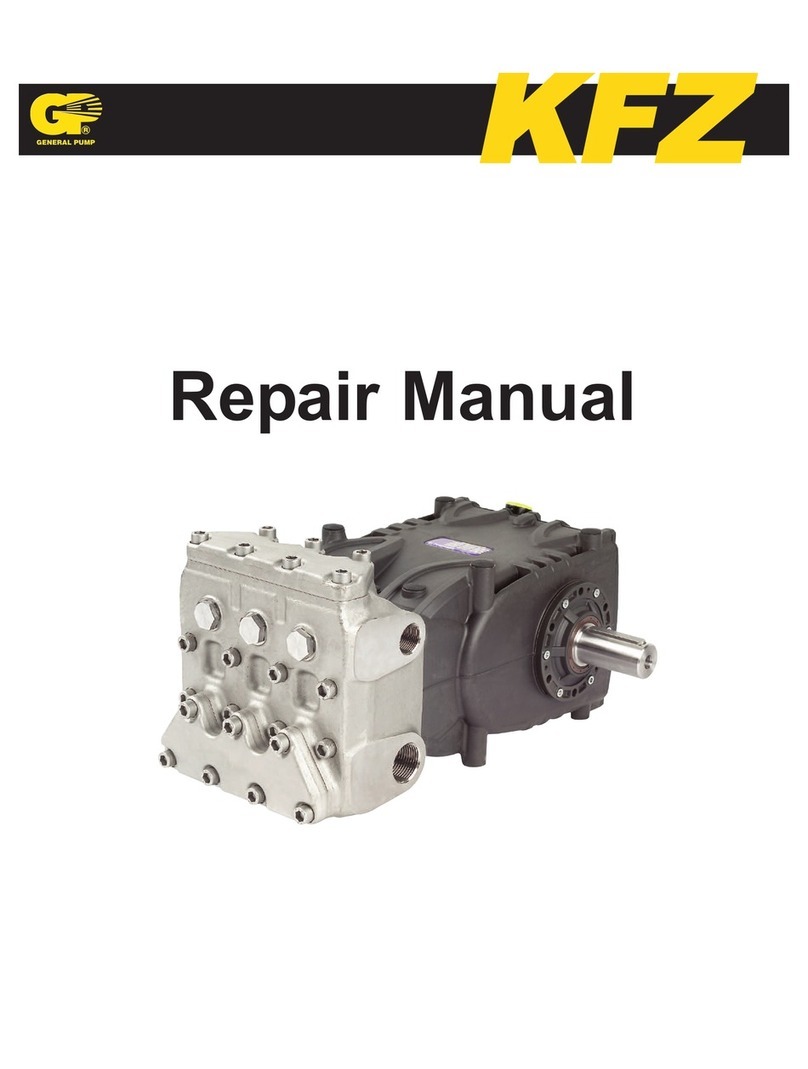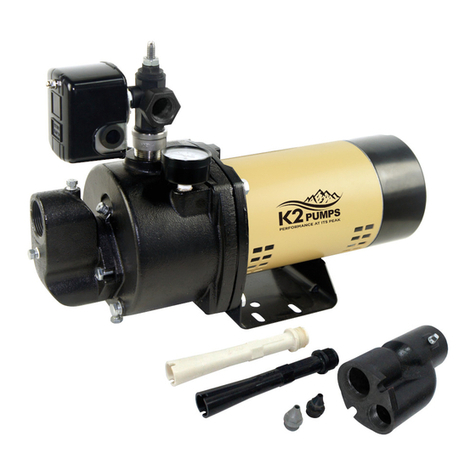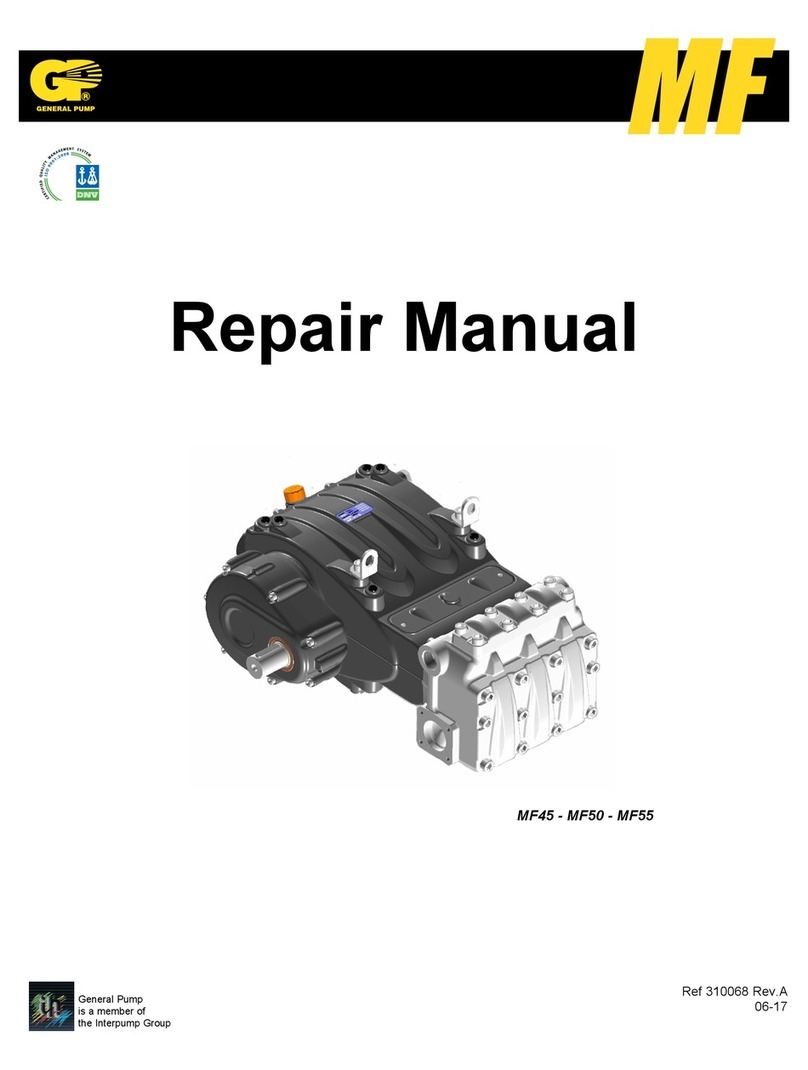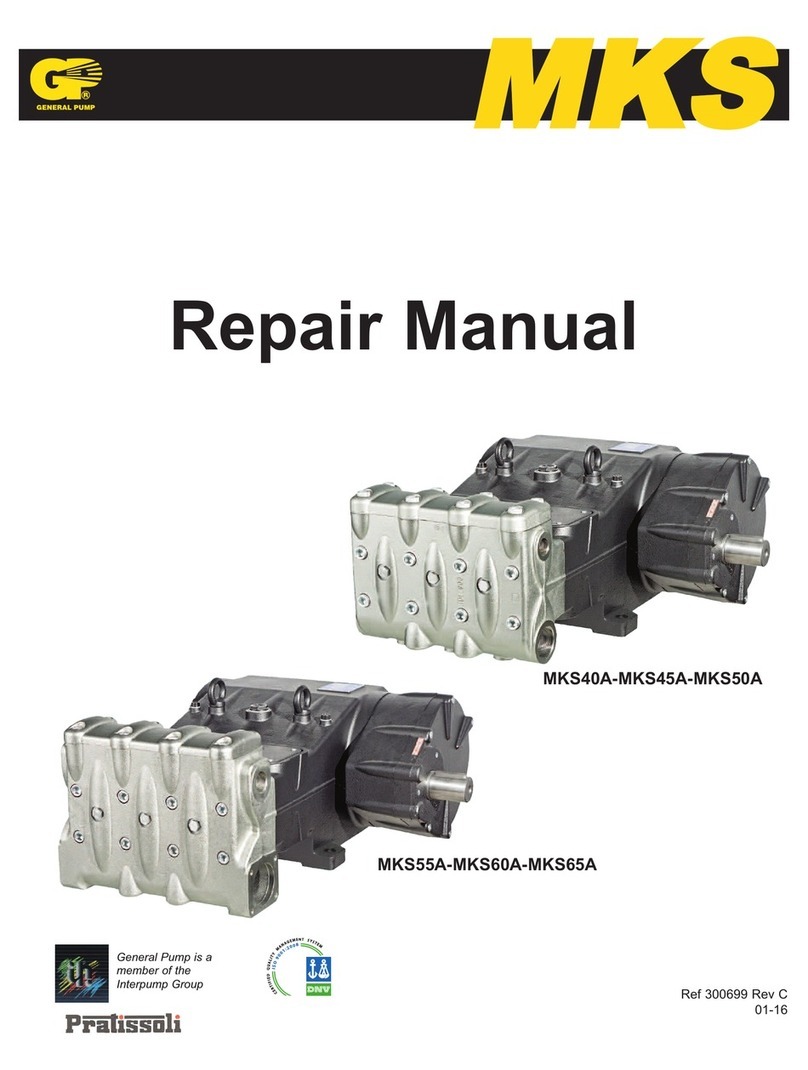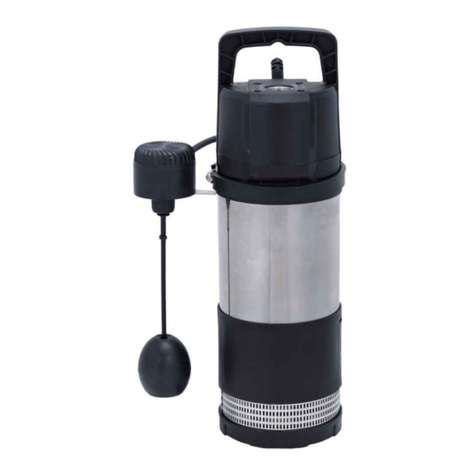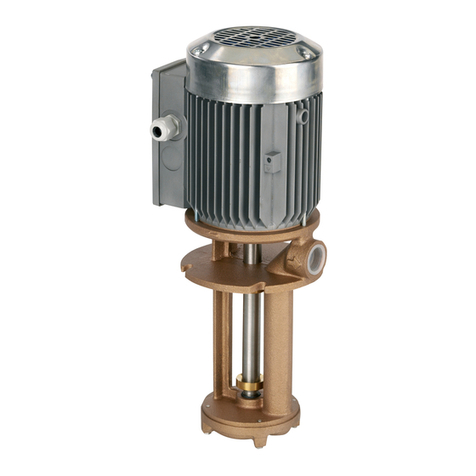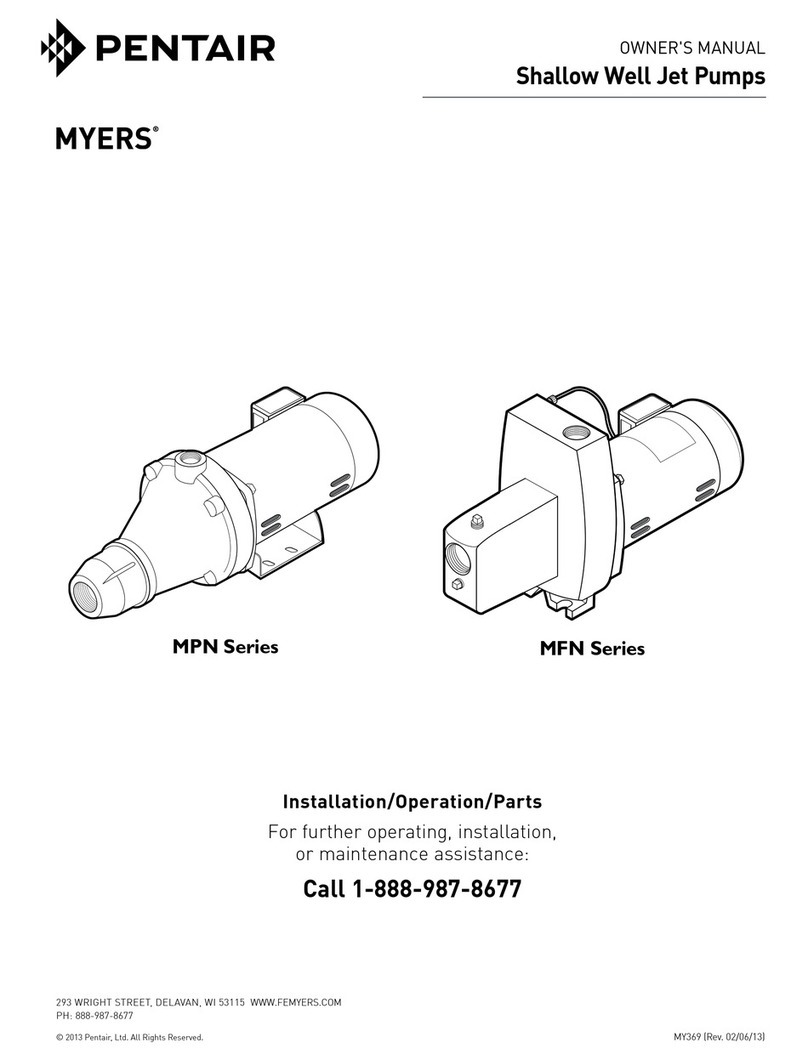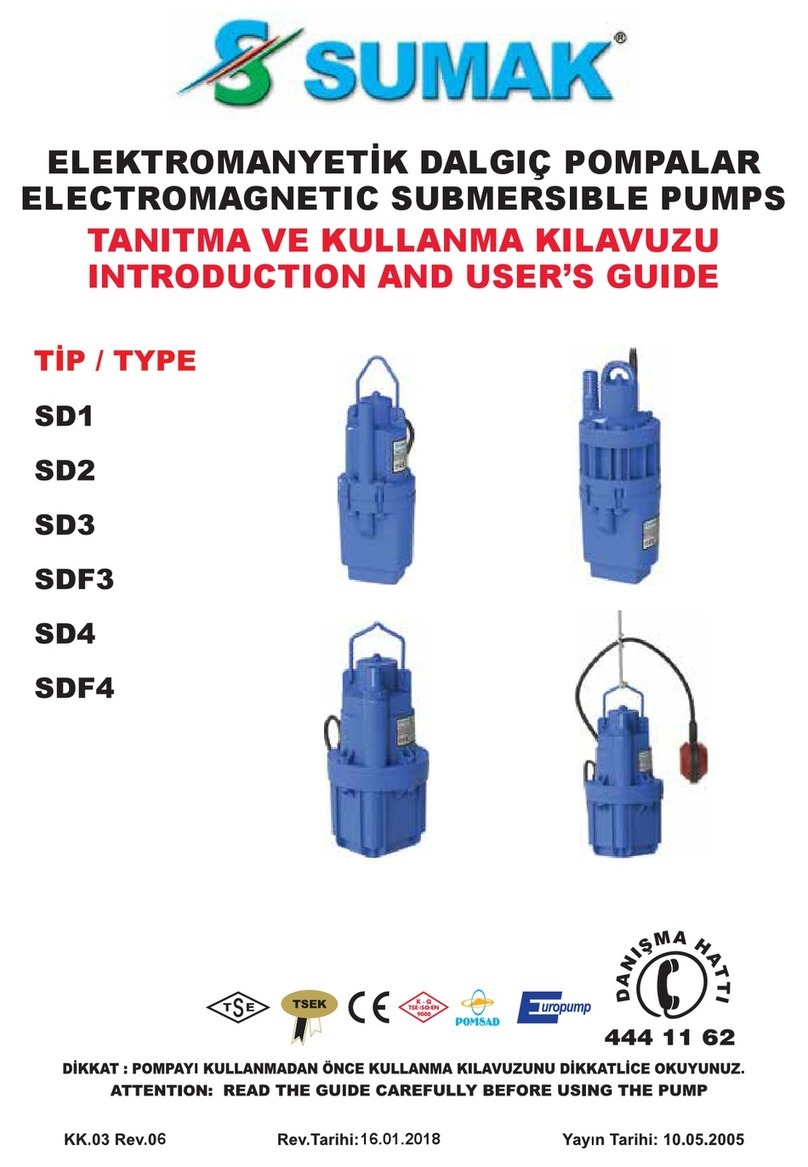GP MW Series User manual

MW
Owner’s Manual
• Installation
• Use
• Maintenance
MWS45A-MWS50A-MWS55A
MW32A-MWS36A-MWS40A
Ref 300790 Rev. H
03-18
General Pump
is a member of
the Interpump Group
8

GENERAL PUMP A member of the Interpump Group
Page 2
INDEX
1. INTRODUCTION ...............................................................Page 4
2. DESCRIPTION OF SYMBOLS ....................................................Page 4
3. SAFETY ......................................................................Page 5
3.1 General safety instructions ....................................................Page 5
3.2 High pressure unit safety requirements...........................................Page 5
3.3 Safety during operation ....................................................... Page 5
3.4 General procedures for using nozzles............................................Page 5
3.5 Safety during unit maintenance .................................................Page 6
4. PUMP IDENTIFICATION .........................................................Page 6
5. TECHNICAL CHARACTERISTICS .................................................Page 7
6. DIMENSIONS AND WEIGHT .....................................................Page 8
7. OPERATING INSTRUCTIONS ....................................................Page 9
7.1 Water temperature ...........................................................Page 9
7.2 Maximum flow and pressure rates...............................................Page 9
7.3 Minimum RPM ..............................................................Page 9
7.4 Recommended lubricant types and Manufacturers .................................. Page 9-10
8. PORTS AND CONNECTIONS ....................................................Page 11
9. PUMP INSTALLATION ..........................................................Page 12
9.1 Installation .................................................................Page 12
9.2 Direction of rotation .......................................................... Page 13
9.3 Version change and reducer positioning ..........................................Page 13
9.4 Hydraulic connections ........................................................Page 14
9.5 Pump power supply ..........................................................Page 14
9.6 Suction line ................................................................Page 15
9.7 Filtration ...................................................................Page 15
9.8 Outlet line..................................................................Page 16
9.9 Internal diameter of hose ......................................................Page 17
9.10 V-belt transmission .........................................................Page 18
10. START UP AND OPERATION ....................................................Page 18
10.1 Preliminary inspections ......................................................Page 18
10.2 Starting up ................................................................Page 19
11. PREVENTATIVE MAINTENANCE .................................................Page 19
12. PUMP STORAGE ..............................................................Page 20
12.1 Filling the pump with anti-corrosion emulsion or anti-freeze ..........................Page 20
12.2 Hoses....................................................................Page 20
13. PRECAUTIONS AGAINST FREEZING..............................................Page 20
14. WARRANTY TERMS............................................................Page 20
15 TROUBLESHOOTING...........................................................Page 21
16. EXPLODED VIEWS AND PARTS..................................................Page 22-25
Ref 300790 Rev. G
03-18
MW SERIES

GENERAL PUMP A member of the Interpump Group
Page 3
INDEX
17. SPECIAL VERSIONS ...........................................................Page 26
17.1 MWN Pump ...............................................................Page 26
17.1.1 Operating instrucions .................................................... Page 26
17.1.2 Water temperature ...................................................... Page 26
17.1.3 Maximum pressure and flow rate ...........................................Page 26
17.1.4 Minimum RPM .........................................................Page 26
17.1.5 Technical characteristics ................................................. Page 26
17.1.6 Dimensions and weight ..................................................Page 27
17.1.7 Exploded view .........................................................Page 31
17.2 MWR Pump ...............................................................Page 32
17.2.1 Operating instrucions .................................................... Page 32
17.2.2 Water temperature ...................................................... Page 32
17.2.3 Maximum pressure and flow rate ...........................................Page 32
17.2.4 Minimum RPM .........................................................Page 32
17.2.5 Technical characteristics ................................................. Page 32
17.2.6 Dimensions and weight ..................................................Page 33
17.2.7 Exploded view .........................................................Page 37
17.3 MWNR Pump .............................................................Page 38
17.3.1 Operating instrucions .................................................... Page 38
17.3.2 Water temperature ...................................................... Page 38
17.3.3 Maximum pressure and flow rate ...........................................Page 38
17.3.4 Minimum RPM .........................................................Page 38
17.3.5 Technical characteristics ................................................. Page 38
17.3.6 Dimensions and weight ..................................................Page 39
17.3.7 Exploded view .........................................................Page 43
17.4 MWF Pump ...............................................................Page 44
17.4.1 Operating instrucions .................................................... Page 44
17.4.2 Water temperature ...................................................... Page 44
17.4.3 Maximum pressure and flow rate ...........................................Page 44
17.4.4 Minimum RPM .........................................................Page 44
17.4.5 Technical characteristics ................................................. Page 44
17.4.6 Dimensions and weight ..................................................Page 44
17.4.7 Minimum Rotating Speed .................................................Page 44
17.4.8 Flushing circuit diagram of use ............................................Page 45
18. REPAIR TOOLS ...............................................................Page 46
19. MAINTENANCE LOG ...........................................................Page 47
Ref 300790 Rev. G
03-18
MW SERIES

Page 4
GENERAL PUMP A member of the Interpump Group
2. SYMBOL DESCRIPTIONS
Warning
Potential Danger
Danger
High Voltage
Danger
Wear protective mask
Danger
Wear goggles
Danger
Wear protective gloves
Danger
Wear protective boots
Read carefully and understand
the manual before operating
the pump
1. INTRODUCTION
This manual describes the use and maintenance instructions of the MW pump, and should be carefully read and
understood before using the pump.
Correct use and adequate maintenance will guarantee the pumps trouble-free operation for a long time. General Pump
declines any responsibility for damage caused by misuse or the non-observance of the instructions indicated in this
manual.
Upon receiving the pump, check that it is complete and in perfect condition. Should anything be found out of order, please
contact us before installing and starting the pump.
Ref 300790 Rev. H
03-18
MW SERIES

Page 5
GENERAL PUMP A member of the Interpump Group
3. SAFETY
3.1 General Safety Indications
Improper use of pumps and high pressure systems, and the non-compliance with installation and maintenance
instructions may cause severe injury to people and/or damage to property. Anyone assembling or usinge high pressure
systems must possess the necessary competence to do so, should be aware of the characteristics of the components
assembled/used, and must take all precautions necessary to ensure maximum safety in any operating condition. In the
interest of safety, both for the Installer and the Operator, no reasonably applicable should be omitted.
3.2 High pressure unit safety requirements
1. The pressure line must always be equipped with a safety valve.
2. High pressure system components, in particular for those units working outside, must be adequately protected
against rain, frost and heat.
3. The electrical control system must be adequately protected from water spray, and must comply with the specific
regulations in force.
4. High pressure hoses must be properly sized for maximum operating pressure of the system and always and only
used within the operating pressure range specified by the hose manufacturer. The same rules should be observed
for all other auxiliary systems affected by high pressure.
5. The ends of high pressure hoses must be sheathed and secured to a solid structure to prevent dangerous
whiplash in case of bursting or broken connections.
6. Appropriate safety guards must be provided for the pump transmission systems (couplings, pulleys and belts,
auxiliary drives).
3.3 Safety During Operation
The working area of a high pressure system must be clearly marked. Access must be prohibited to un-authorized
personnel and, wherever possible, the area should restricted or fenced. The personnel authorized to access this area
should first be trained, and informed about the risks that may arise from failures or malfunctions of the high pressure unit.
Before starting the unit, the operator must check:
1. That the high pressure system is properly powered (see paragraph 9.5).
2. That pump intake filters are perfectly clean; we advise the use of a device that indicates the filters clogging level.
3. Electrical parts are adequately protected and in perfect condition.
4. The high pressure hoses do not show apparent signs of abrasion, and that fittings are in perfect shape.
Any fault or reasonable doubt that may arise before or during operation should be promptly reported and verified by
competent personnel. In these cases, pressure should immediately be released and the high pressure system stopped.
3.4 General Procedures For Using Nozzles
1. The Operator must always place his own and other worker’s safety before any other interest; his and should always
be governed by good sense and responsibility.
2. The Operator must always wear a helmet with a protective visor, waterproof clothing, and appropriate boots capable
of guaranteeing grip on wet pavement.
Ref 300790 Rev. H
03-18
MW SERIES

Page 6
GENERAL PUMP A member of the Interpump Group
Note: appropriate clothing will effectively protect against water spray, but it may not offer adequate protection against the
direct impact of water jets or sprays from a close distance. Some circumstances may require further protection.
3. It is generally best to organize personnel into teams of at least two people capable of giving mutual and immediate
assistance in case of necessity and of taking turns during long and demanding operation.
4. Access to the work area that is within the water jets’ range must be absolutely prohibited to and free from objects
that, inadvertently under a pressure jet, can be damaged and or create dangerous situations.
5. The water jet must only and always be directed in the direction of the work area, including during testing or
preliminary tests or checks..
6. The Operator must always pay attention to the trajectory of the debris removed by the water jet. If neces-
sary, suitable guards must be provided by the Operator to protect anything that may be accidentally exposed.
7. The Operator should not be distracted for any reason during operation. Workers needing to access the operating
area must wait for the Operator to stop work, and then immediately make their presence known.
8. For safety reasons, it is important that each member of the team is fully aware of the intentions and actions of
other team members in order to avoid dangerous misunderstandings.
9. The high pressure system must not be started up and run under pressure without all team members in position
and without the Operator having already directed his/her lance toward the work area.
3.5 Safety During System Maintenance
1. The pressure system meintenance must be carried out in the time intervals set by the manufacturer who is
responsible for the whole group according to law.
2. Maintenance should always be carried out by trained and authorized personnel.
3. Assembly and disassembly of the pump and its various components must be performed exclusively by autho-
rized personnel, using appropriate equipment in order to avoid damage to components and connections.
4. Always use original spare parts to ensure total reliability and safety.
4. PUMP IDENTIFICATION
Each pump has a specific label which contains:
Pump model and version
Serial Number
Flow Rate - GPM
Pressure - PSI
Power - Hp-kW
Maximum RPM
Pump model, version and serial number must always
be specified when ordering spare parts.
Ref 300790 Rev. H
03-18
MW SERIES

GENERAL PUMP A member of the Interpump Group
Page 7
5. TECHNICAL FEATURES
MODEL RPM FLOW RATE PRESSURE POWER
GPM l/min PSI Bar Hp kW
MW32A 1500/1800/2200 36.0 136 4350 300 106 79
MWS36A 1500/1800/2200 45.5 172 3900 269 121 90
MWS40A 1500/1800/2200 56.0 213 3050 210 117 87
MWS45A 1500/1800/2200 71.0 269 2500 172 121 90
MWS50A 1500/1800/2200 87.5 333 2000 138 119 88
MWS55A 1500/1800/2200 105.5 400 1450 100 104 77.5
Ref 300790 Rev. H
03-18
MW SERIES

GENERAL PUMP A member of the Interpump Group
Page 8
6. DIMENSIONS AND WEIGHT
fig. 2
Weight: 540 Lbs./244 Kg.
For dimensions and weight of MW32A, MWS36A and MWS40A pumps, please refer to fig. 2.
fig. 2a
Weight: 540 Lbs./245 Kg.
For dimensions and weight of MWS45A, MWS50A and MWS55A pumps, please refer to fig. 2a.
Ref 300790 Rev. H
03-18
MW SERIES

GENERAL PUMP A member of the Interpump Group
7.INFORMATION ABOUT PUMP USE
The MW/S pump was designed to operate with filtered water (see paragraph 9.7) and at
maximum temperature of 1040F (400C).
Other fluids may be used only upon the approval of The Customer Service Department .
7.1 WaterTemperature
The max water temperature is 1040F (400C).However, it is possible to use the pump at temperatures
of up to 1400F (600C) for short periods of time. In this case we advise consulting the Customer Service
Department.
7.2 Max Flow Rate and Pressure Values
The performance values indicated in the catalog refer to the maximum performance of the pump. Regardless of the power
used, pressure and maximum RPM values indicated on the plate may not be exceeded unless expressly authorized by the
Customer Service Department.
7.3 Lowest RPM
Any RPM value different from what is indicated in the performance table (see chapter 5) must be expressly authorized by
the Customer Service Department.
7.4
Recommended Lubricant Oil Types & Manufacturers
The pump is delivered with lubricant oil compliant with room temperatures ranging between 320and 89.60F (00and
300C ). Some recommended lubricant types are indicated in the table below; these lubricants are treated with additives
in order to increase corrosion protection and resistance to fatigue. As an alternative, Automotive SAE 85W-90 gearing
lubricants may also be used.
BRAND TYPE
GENERAL PUMP SERIES 220
ARAL Aral Degol BG220
BP ENERGOL HLP 220
CASTROL
Hyspin VG 220, Magna
220
ELF
POLYTELIS 220
ESSO NUTO 220
FINA Cirkan 220
FUCHS RENOLIN 220
MOBIL DTE OIL BB
SHELL TELLUS C 220
TEXACO RANDO HD 220
TOTAL CORTIS 220
Check the oil level by using the oil level dipstick (1),
fig. 3. Refill if necessary to top off level. Correct oil level
inspection is done with the pump at room temperature;
oil is changed with the pump at working temperature, by
removing the rear plug (2), fig 3..
Checking and changing oil is to be carried out as indicated
in Chapter 11. The amount required is 304 oz. (9 liters).
Page 9
Ref 300790 Rev. H
03-18
MW SERIES

GENERAL PUMP A member of the Interpump Group
Page 10
In any case, oil must be changed at least once a year since it may deteriorate by oxidation.
For room temperatures that differ from that mentioned earlier, follow the indications contained in the diagram
below, keeping in mind that the oil must have a minimum viscosity of 180 cSt.
VISCOSITY/ROOM TEMPERATURE DIAGRAM
Exhausted oil must be collected in an appropriate recipient and disposed of in appropriate
locations. In absolutely no case may it be dispersed into the environment.
Ref 300790 Rev. H
03-18
MW SERIES

GENERAL PUMP A member of the Interpump Group
Page 11
8. PORTS AND CONNECTIONS
MW/S Series pumps are equipped with (see fig. 4 and 4a):
1. 2 inlet ports “IN”, 2” NPT (MW32A, MWS36A, MWS40A).
2 inlet ports “IN”, 2-1/2” NPT (MWS45A, MWS50A, MWS55A).
The line can be connected to either of the two inlet ports; the ones not being used must be hermetically sealed.
2. 2 outlet ports “OUT”, Ø 1” NPT-F (MW32A, MWS36A, MWS40A).
2 outlet ports “OUT”, Ø 1-1/4” NPT-F (MWS45A, MWS50A, MWS55A).
3. 1 drain port “DRAIN” with G1/2” hole in the lower cover to monitor any water leakage due to wear of the pressure
packings. In case of leaks, please consult the repair manual.
This hole must always be kept open.
Ref 300790 Rev. H
03-18
MW SERIES

GENERAL PUMP A member of the Interpump Group
Page 12
The pump’s shaft (PTO) must not be rigidly connected to the motor unit.
The following transmission types are suggested:
• Flexible joint
• Cardan Joint (please respect the maximum working angles indicated by the manufacturer)
• Belts; for correct application, please contact the Customer Service Department.
9. PUMP INSTALLATION
9.1 Installation
The pump must be installed in a horizontal position using the M16 threaded support feet.
Tighten the screws with a torque of 200 Nm (147.5 Ft-Lb)
The base must be perfectly flat and rigid enough as not to allow bending or misalignment on the pump coupling and
axis/transmission due to torque transmitted during operation.
Two lifting brackets are mounted on the pump for easy installation, as per the figure below.
Replace the oil filling hole closing service plug positioned on the rear casing cover with the
plug with oil dipstick. Check the correct quantity.
The dipstick must always be reachable, even when the unit is assembled.
The brackets are sized soley for pump lifting and therefore are absolutely not permitted for use
of additional loads.
Ref 300790 Rev. H
03-18
MW SERIES

GENERAL PUMP A member of the Interpump Group
Page 13
9.2 Direction of rotation
The PTO rotation is indicated by an arrow located on the reduction gear cover. From a position facing the pump head,
the rotation direction will be as in fig. 5.
The version may be changed only by trained and authorized personnel by carefully
following the instructions in the repair manual.
9.3 Version Change and Reducer Positioning
A right version pump is defined when: observing the pump from the head side, the PTO shank of the pump shaft is on
the right side.
A left version pump is defined when: observing the pump from the head side, the PTO shank is on the left side.
See fig. 5.
1. Separate the pump head from the power end (crankcase) as indicated in Chapter 2 in points 2.2.1 and 2.2.3 of the
Repair Manual.
2. Turn the power end (crankcase) 180oand reposition the rear casing cover in such a way that the oil dipstick is
turned upward. Reposition the lifting bracket and relative hole closing plugs in the upper part of the casing. Invert
the two inspection covers, ensuring that the open one is positioned lower. Finally, properly reposition the
specification label in its housing on the casing.
Make sure that the lower inspection cover draining holes are open.
3. Reassemble the pump head with the power end (crankcase( as indicated in Chapter 2 in points 2.2.1 and 2.2.4 of
the Repair Manual.
It is also possible to place the reduction gear in 5 different positions as per fig. 6.
Ref 300790 Rev. H
03-18
MW SERIES

GENERAL PUMP A member of the Interpump Group
Page 14
9.4 Hydraulic Connections
In order to isolate the system from the vibrations produced by the pump, we advise to build the first section of the duct
near the pump (both for intake and delivery) with flexible hose. The consistency of the intake section must allow to avoid
deformation caused by the depressurization produced by the pump.
9.5 Pump Power Supply
MW/S pumps must always be installed under positive head, i.e. they must receive water by gravity or by forced feeding,
and never suctioned from a lower level. The pumps can tolerate minimum NPSH even as low as 1 m. (3.28 ft.), howev-
er, to obtain a better volumetric efficiency and above all to avoid cavitation, the minimum NPSH available, measured at
the pump inlet flange, will have to be at least equal or higher than the values shown in the chart below.
The reducer’s position may be changed only by trained and authorized personnel by carefully following
the instructions in the repair manual.
fig. 6
MW32A MWS36A MWS450A MWS45A MWS50A MWS55A
NPSHr(ft) 4.5 5.5 6.5 7.5 8 9
For higher cylinder capacity pumps (MWS45A-S50A-S55A), it is strongly recommended to use a booster pump to avoid
cavitation, in view of the geometry on the hydraulic section and of the remarkably high flow rates.
The booster pump must have the following specifications: flow rate at least double the rated flow rate of the pump, and
pressure between 30 to 40 PSI (2 to 3 Bar). These feeding conditions must be respected at any operating RPM.
Booster start-up must always precede plunger pump start-up. In order to protect the pump, we advise to
install a pressure switch on the feeding line after the filters.
Ref 300790 Rev. H
03-18
MW SERIES

GENERAL PUMP A member of the Interpump Group
Page 15
9.6 Suction Line
For the pump’s correct operation, the suction line must have the following characteristics:
1. Minimum internal diameter as indicated in the diagram in paragraph 9.9, and in any case equal or greater than
the pump head’s value. Along the duct, avoid localized diameter reductions that may cause pressure drops with
subsequent cavitation. Absolutely avoid 900elbows, connections with other hoses, bottlenecks, counter-slopes,
upside down “U” shaped curves, “T” connections.
2. With a layout that is set in such a way to prevent cavitation.
3. It should be perfectly airtight, and built in a way that guarantees perfect sealing over time.
4. Avoid pump emptying when stopping (even partial emptying).
5. Do not use hydraulic fittings, 3 or 4 way fittings, adapters, etc., since they may hinder the pump’s performance.
6. Do not install Venturi tubes or injectors for detergent intake.
7. Avoid the use of standing valves, check valves, or any other type of one-way valves.
8. Do not connect the by-pass line from the valve directly to the pump suction line.
9. Provide appropriate baffle plates inside the tank in order to avoid water flows coming from both the by-pass and
feeding which lines may create turbulance near the tank’s outlet port.
10. Make sure that the suction line is perfectly clean inside before connecting it to the pump.
11. The pressure gauge for checking booster pressure must be installed near the plunger pump’s inlet port, and always
downstream from the filters.
9.7 Filtering
On the suction line, install two filters as indicated in fig. 7 and fig. 7/a.
With the manual adjustment valve:
Ref 300790 Rev. H
03-18
MW SERIES

GENERAL PUMP A member of the Interpump Group
Page 16
With the pneumatic adjustment valve:
The filter must be installed as close as possible to the pump, should allow easy inspection and have the following
characteristics:
1. Minimum capacity 3 times greater than the pump’s rated flow value.
2. Filter port diameters must not be smaller than the pump inlet ports.
3. Filtration degree ranging between 200 and 360 µm.
In order to guarantee correct pump operation, it is important to plan periodical cleaning of the filter
depending on actual pump usage, water quality and actual clogging conditions.
9.8 Outlet Line
To obtain a correct delivery line, please comply with the following installation instructions:
1. The internal diameter of the hose must allow to guarantee correct fluid speed; see digram in paragraph 9.9
2. The first section of the hose connected to the pump must be flexible in order to isolate pump vibrations
from the rest of the system.
3. Use high pressure hoses and fittings that guarantee wide safety margins in any working condition.
4. Install a safety valve on the delivery line.
5. Use pressure switches suitable for the pulsating loads typical of plunger pumps.
6. In the design phase, take into proper account the pressure drop along the line, since this causes a reduction in
usage pressure with respect to the value measured at the pump.
7. If the pump pulsations are harmful for particular applications, install an appropriately sized pulsation dampener on
the outlet line.
Ref 300790 Rev. H
03-18
MW SERIES

Page 17
GENERAL PUMP A member of the Interpump Group
9.9 Internal Diameter of the Hose Line
To determine the internal diameter of the hose, please refer to the following diagram.
Suction Hose
With a flow rate of ~105 GPM (400 l/mn) and water speed of 1 m/sec. the diagram line that connects the two scales
intersects the central scale, indicating the diameters, at a value of ~ 3.5 inch (90 mm).
Delivery Hose
With a flow rate of ~105 GPM (400 l/mn) and water speed of 5.5 m/sec. The diagram line that connects the two scales
intersects the central scale, indicating the diameters at a value of ~ 1.6 inch (40 mm).
Optimal speed to be obtained with the booster pump:
• Suction: ≤ 1 m/sec.
• Delivery: ≤ 5.5 m/sec.
The diagram does not take into account the hose and valve resistance, the pressure drop due to the pipe length,
the viscosity and the temperature of the pumped fluid. If necessary, contact our Customer Service Department.
Ref 300790 Rev. H
03-18
MW SERIES

GENERAL PUMP A member of the Interpump Group
Page 18
9.10 V-belt Transmission
As indicated in paragraph 9.1, only in exceptional cases may the pump be driven by a v-belt system. For correct lay-out
sizing, please contact our Customer Service Department.
10. START-UP AND OPERATION
10.1 Preliminary Inspections
Before Start-up Be sure that:
The suction line is connected and up to pressure (see Chapter 9) the pump must never run dry.
1. The suction line must be perfectly airtight.
2. All the On-Off valves between the pump and the feeding source are completely open. The delivery line must
discharge freely in order to allow the air in the pump to be expulsed easily, thus facilitating pump priming.
3. All suction/delivery connections and fittings must be correctly tightened.
4. Coupling tolerances on the pump/transmission axis (half-joint misalignment, Cardan inclination, belt
tightening, etc.) must remain within the limits indicated by the transmission Manufacturer.
5. The pump’s oil level must be verified using the correct dipsticks (position 1, fig 8).
In case the pump has not run for a long period of time, recover the correct operation of the suction valves
by opening the three valve-lifting devices (see position 2, fig. 9). Be sure to reclose the valves before the
pump start-up. See fig. 10 for “work” and “rest” positions.
fig. 10
Ref 300790 Rev. H
03-18
MW SERIES

GENERAL PUMP A member of the Interpump Group
Page 19
10.2 Start-up
1. When starting the pump for the first time, check for the correct direction of rotation.
2. The pump must be started off-load.
3. Verify correct feeding pressure.
4. During operation, check that the rotating speed does not exceed the rated value.
5. Before putting the pump under pressure let it run for at least 3 minutes.
6. Before stopping the pump, release the pressure by acting on the adjustment valve or on any discharging device.
Whenever priming problems arise due to insufficient feeding, intervene by removing the three front plugs
on the head (see position 3, fig. 11 and 11a).
11. PREVENTIVE MAINTENANCE
PREVENTIVE MAINTENANCE
EVERY 500 HOURS EVERY 1000 HOURS
Check oil level Change oil
Check / Replace:*
• Valves
• Valve seats
• Valve springs
• Valve guides
Check / Replace:
• H.P packings
• L.P. packings
To guarantee pump reliability and efficiency, comply with the maintenance intervals as indicated in the table below.
* For replacement follow instructions contained in the repair manual.
Ref 300790 Rev. H
03-18
MW SERIES

GENERAL PUMP A member of the Interpump Group
12.
PUMP STORAGE
12.1 Filling the Pump With An Anti-Corrosion Emulsion or Anit-freeze By Using An External Diaphragm Pump
As In The Layout Shown in Paragraph 9.7.
a) Close the filter draining, if open.
b) Be sure that the connecting hose is clean, spread with grease and connect it to the high pressure outlet port.
c) Fit a suction hose to the membrane pump. Open the pump suction connection and fit hose between it and the
membrane pump.
d) Fill the container with the solution/emulsion.
e) Put the free extremeties of the suction line and the high pressure outlet hose inside the container.
f) Start up the diphragm pump.
g) Pump the emulsion until it comes out of the high pressure hose.
h) Continue pumping for at least another minute; if needed, the emulsion can be reinforced by adding, for example,
Shell Donax
i) Stop the pump, remove the hose from the suction connection and close it with a plug.
j) Remove the hose from the high pressure outlet port. Clean, grease and plug both connections and the
hoses.
12.2 Hoses
a) Before greasing and protecting the hoses according to the previously described procedure, dry the connections
using compressed air.
b) Cover with polyethelene.
c) Do not wrap them too tightly; be sure there is no bending.
13.
PRECAUTIONS AGAINST FREEZING
In areas and periods of the year where there is risk of freezing, follow the instructions indicated in Chapter 12
(see paragraph 12.1).
In the presence of ice, in no case must the pump be started until the entire circuit has been completely
thawed out; not complying with this indication may cause serious damage to the pump.
14.
WARRANTY TERMS
The pump is guaranteed for a period of 5 years from the delivery date, with the exception of parts subject to wear. In
any case, please refer to the contract terms for other warranty conditions. The warranty is void if:
a) The pump has been used for purposes that differ from that agreed.
b) The pump has been fit with an electric or diesel engine with performance greater than that indicated in the table.
c) The required safety devices were un-adjusted or disconnected.
d) The pump was used with accessories or spare parts not supplied by General Pump.
e) Damage was caused by:
1) improper use
2) the non-observance of maintenance instructions
3) use not compliant with operating instructions
4) insufficient flow rate
5) faulty installation
6) incorrect positioning or sizing of the hoses
7) non-authorized design changes
8) cavitation
Page 20
Ref 300790 Rev. H
03-18
MW SERIES
This manual suits for next models
6
Table of contents
Other GP Water Pump manuals
Popular Water Pump manuals by other brands
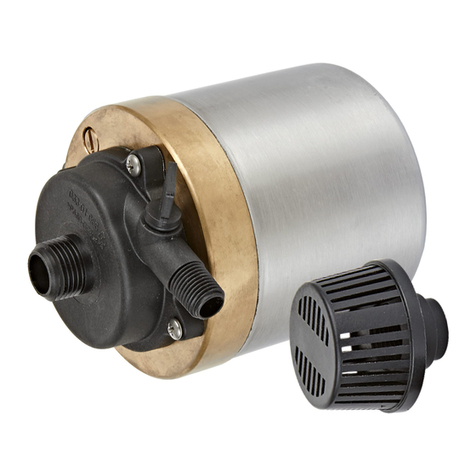
Little Giant
Little Giant S Series owner's manual

North American Solar Solutions
North American Solar Solutions NASS 500 manual
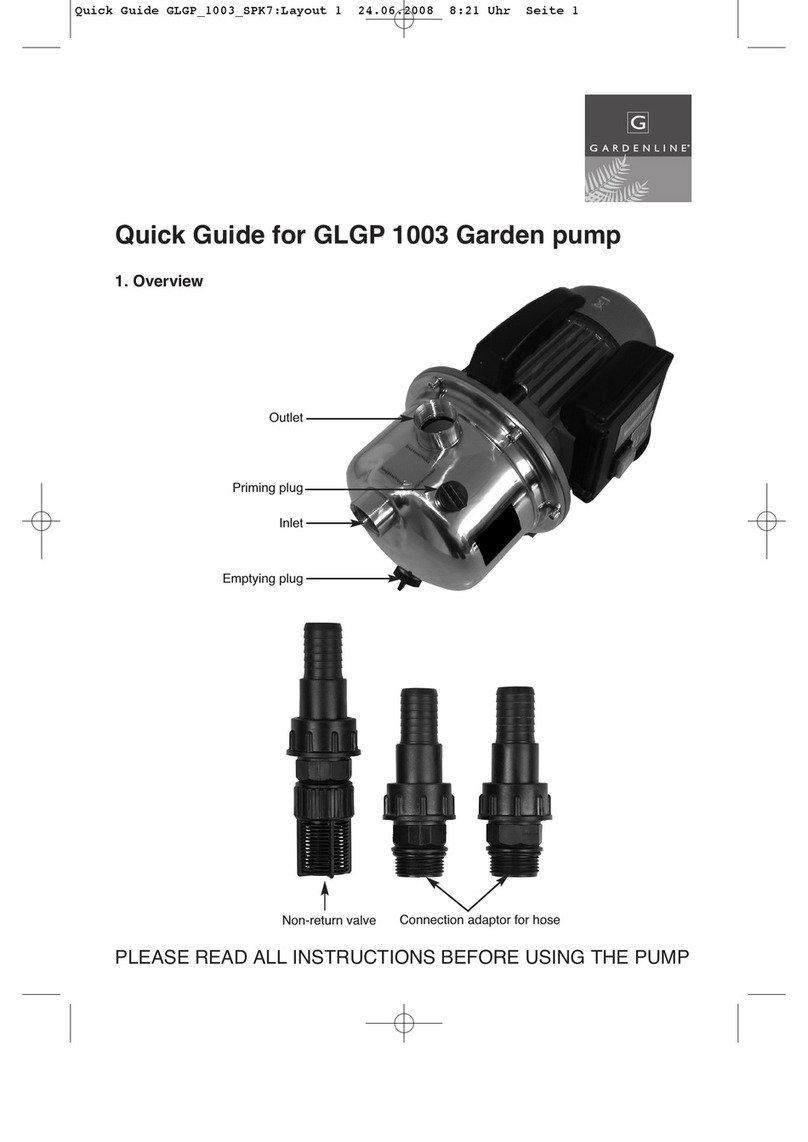
Gardenline
Gardenline GLGP 1003 quick guide
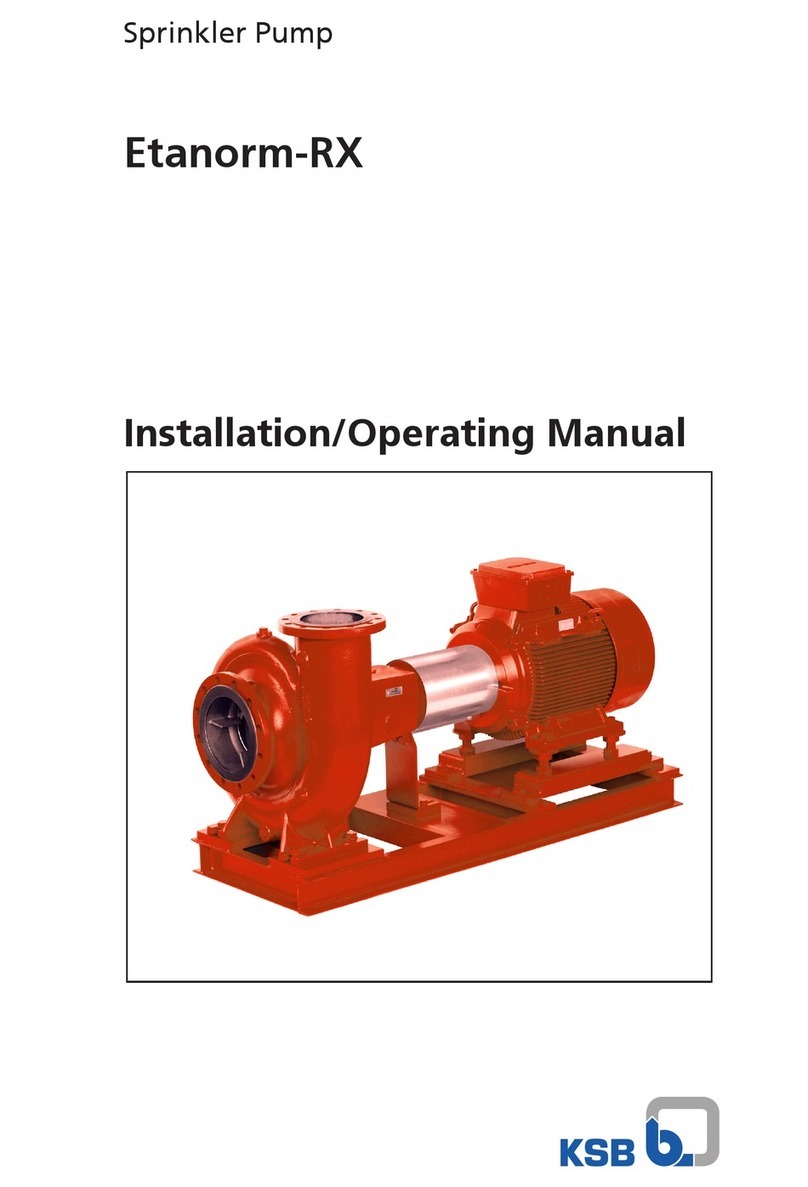
KSB
KSB Etanorm-RX Installation & operating manual

Hi-Force
Hi-Force HPX2800 operating instructions
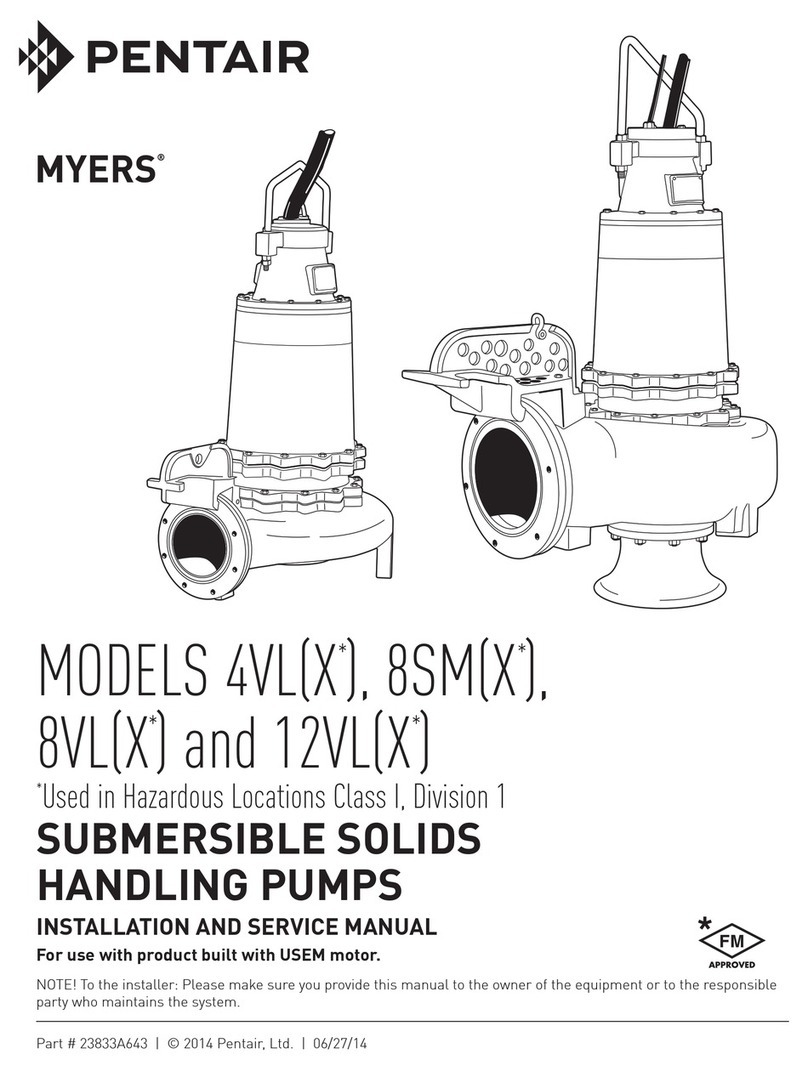
Pentair
Pentair Myers 4VL Installation and service manual

Viking pump
Viking pump 4624B Series Installation, operation & maintenance instructions

SPERONI
SPERONI CFM operating instructions

CAT Pumps
CAT Pumps 67DX39G1I Service manual

Catalyst
Catalyst 77722-00 operating manual
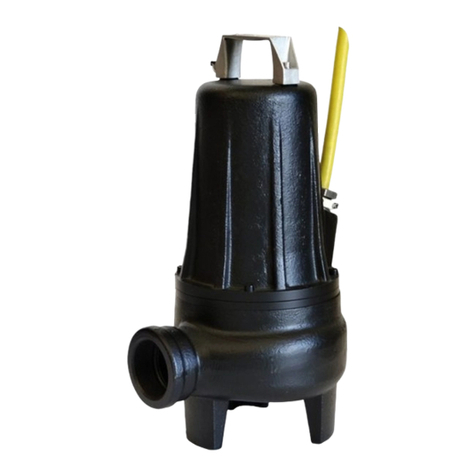
DRENO
DRENO Compatta PRO Series User and maintenance manual
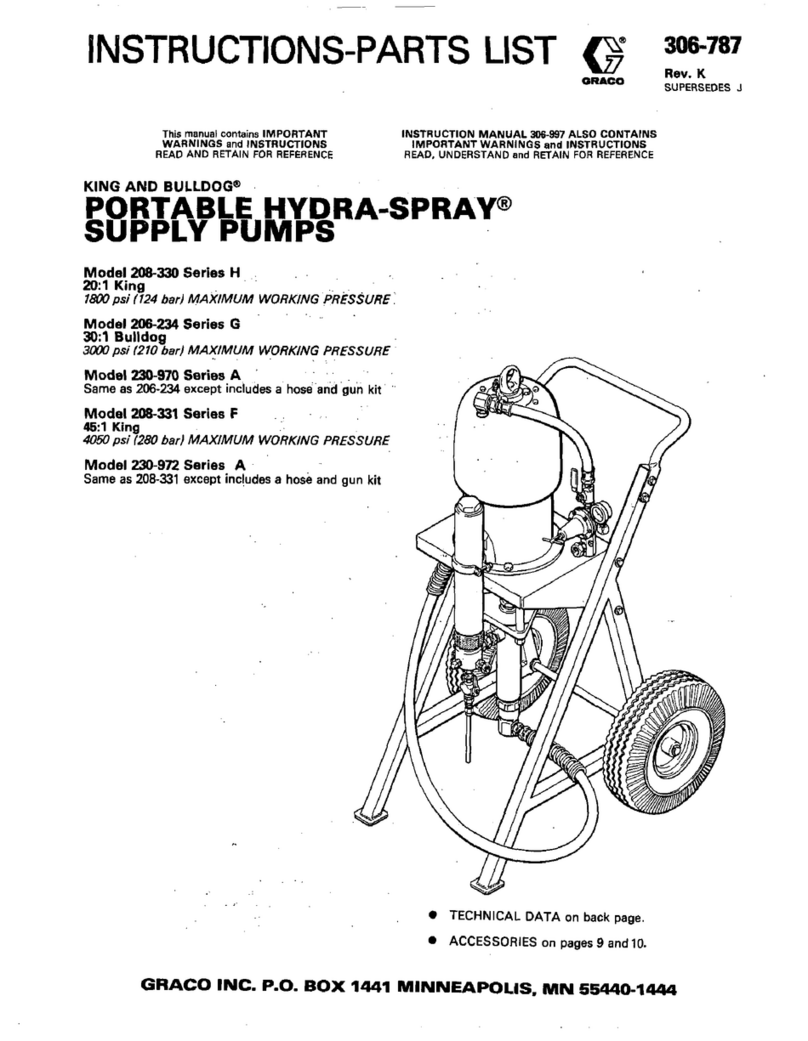
Graco
Graco H Series Instructions-parts list
